Data Fusion and Accuracy Analysis of Multi-Source Land Use/Land Cover Datasets along Coastal Areas of the Maritime Silk Road
Abstract
1. Introduction
2. Study Area and Materials
2.1. Study Area
2.2. Materials
2.3. Data Pre-Processing
3. Fusion Principle and Methods
3.1. Techniques
3.2. Establishment of Target Classification System
3.3. Agreement Analysis of Input Data Sources
3.4. Reconstruction of Disagreements
3.5. Accuracy Analysis Methods
4. Fusion Results and Accuracy Analysis
4.1. Fusion Results of Multi-Source Land Use/Land Cover Datasets
4.2. Accuracy Analysis Based on Google Earth Sampling
4.3. Mutual Validation of Multi-Source Land Use/Land Cover Datasets
4.4. Consistencies of Multi-Source Land Use/Land Cover Datasets
5. Discussion
5.1. Superiority and Summary
5.2. Limitation and Outlook
5.3. Previous Work and Follow-up Research
6. Conclusions
Author Contributions
Funding
Acknowledgments
Conflicts of Interest
Appendix A
| Initial Type | Target Type | |||||||
|---|---|---|---|---|---|---|---|---|
| 1 | 2 | 3 | 4 | 5 | 6 | 7 | 8 | |
| 1 | 4 | 0 | 0 | 0 | 0 | 0 | 0 | 0 |
| 2 | 0 | 4 | 0 | 0 | 0 | 0 | 0 | 0 |
| 3 | 0 | 0 | 4 | 0 | 0 | 0 | 0 | 0 |
| 4 | 0 | 0 | 0 | 4 | 0 | 0 | 0 | 0 |
| 5 | 0 | 0 | 0 | 0 | 4 | 0 | 0 | 0 |
| 6 | 0 | 0 | 0 | 0 | 0 | 4 | 0 | 0 |
| 7 | 0 | 0 | 0 | 0 | 0 | 0 | 4 | 0 |
| 8 | 0 | 0 | 0 | 0 | 0 | 0 | 0 | 4 |
| 10 | 0 | 4 | 0 | 0 | 0 | 0 | 0 | 0 |
| 20 | 0 | 4 | 0 | 0 | 0 | 0 | 0 | 0 |
| 30 | 0 | 4 | 0 | 0 | 0 | 0 | 0 | 0 |
| 40 | 0 | 4 | 0 | 0 | 0 | 0 | 0 | 0 |
| 50 | 0 | 4 | 0 | 0 | 0 | 0 | 0 | 0 |
| 60 | 0 | 0 | 0 | 4 | 0 | 0 | 0 | 0 |
| 70 | 0 | 0 | 0 | 4 | 0 | 0 | 0 | 0 |
| 80 | 0 | 2 | 3 | 0 | 0 | 0 | 0 | 0 |
| 90 | 0 | 1 | 3 | 1 | 0 | 0 | 0 | 0 |
| 100 | 0 | 0 | 4 | 0 | 0 | 0 | 0 | 0 |
| 110 | 0 | 0 | 0 | 0 | 4 | 0 | 0 | 0 |
| 120 | 4 | 0 | 0 | 0 | 0 | 0 | 0 | 0 |
| 130 | 0 | 0 | 0 | 0 | 0 | 4 | 0 | 0 |
| 140 | 3 | 1 | 1 | 1 | 0 | 0 | 0 | 0 |
| 150 | 0 | 0 | 0 | 0 | 0 | 0 | 0 | 4 |
| 160 | 0 | 1 | 1 | 1 | 0 | 0 | 3 | 0 |
| 170 | 0 | 0 | 0 | 0 | 4 | 0 | 0 | 0 |
Appendix B
| Initial Type | Target Type | |||||||
|---|---|---|---|---|---|---|---|---|
| 1 | 2 | 3 | 4 | 5 | 6 | 7 | 8 | |
| 1 | 4 | 0 | 0 | 0 | 0 | 0 | 0 | 0 |
| 2 | 0 | 4 | 0 | 0 | 0 | 0 | 0 | 0 |
| 3 | 0 | 0 | 4 | 0 | 0 | 0 | 0 | 0 |
| 4 | 0 | 0 | 0 | 4 | 0 | 0 | 0 | 0 |
| 5 | 0 | 0 | 0 | 0 | 4 | 0 | 0 | 0 |
| 6 | 0 | 0 | 0 | 0 | 0 | 4 | 0 | 0 |
| 7 | 0 | 0 | 0 | 0 | 0 | 0 | 4 | 0 |
| 8 | 0 | 0 | 0 | 0 | 0 | 0 | 0 | 4 |
| 11 | 3 | 0 | 2 | 0 | 0 | 0 | 0 | 0 |
| 12 | 3 | 2 | 0 | 2 | 0 | 0 | 0 | 0 |
| 20 | 4 | 0 | 0 | 0 | 0 | 0 | 0 | 0 |
| 30 | 3 | 1 | 1 | 1 | 0 | 0 | 0 | 0 |
| 40 | 2 | 2 | 2 | 2 | 0 | 0 | 0 | 0 |
| 50 | 0 | 4 | 0 | 0 | 0 | 0 | 0 | 0 |
| 61 | 0 | 4 | 0 | 0 | 0 | 0 | 0 | 0 |
| 62 | 0 | 3 | 1 | 1 | 0 | 0 | 0 | 0 |
| 71 | 0 | 4 | 0 | 0 | 0 | 0 | 0 | 0 |
| 72 | 0 | 3 | 1 | 1 | 0 | 0 | 0 | 0 |
| 81 | 0 | 4 | 0 | 0 | 0 | 0 | 0 | 0 |
| 82 | 0 | 3 | 1 | 1 | 0 | 0 | 0 | 0 |
| 90 | 0 | 4 | 0 | 0 | 0 | 0 | 0 | 0 |
| 100 | 0 | 3 | 2 | 3 | 0 | 0 | 0 | 0 |
| 110 | 0 | 2 | 3 | 2 | 0 | 0 | 0 | 0 |
| 121 | 0 | 0 | 0 | 4 | 0 | 0 | 0 | 0 |
| 122 | 0 | 0 | 0 | 4 | 0 | 0 | 0 | 0 |
| 130 | 0 | 0 | 4 | 0 | 0 | 0 | 0 | 0 |
| 140 | 0 | 0 | 0 | 0 | 4 | 0 | 0 | 0 |
| 152 | 0 | 0 | 0 | 2 | 0 | 0 | 3 | 0 |
| 153 | 0 | 0 | 2 | 0 | 0 | 0 | 3 | 0 |
| 160 | 0 | 2 | 0 | 0 | 3 | 0 | 0 | 0 |
| 170 | 0 | 2 | 0 | 0 | 3 | 0 | 0 | 0 |
| 180 | 0 | 0 | 2 | 2 | 3 | 0 | 0 | 0 |
| 190 | 0 | 0 | 0 | 0 | 0 | 4 | 0 | 0 |
| 201 | 0 | 0 | 0 | 0 | 0 | 0 | 4 | 0 |
| 202 | 0 | 0 | 0 | 0 | 0 | 0 | 4 | 0 |
| 210 | 0 | 0 | 0 | 0 | 4 | 0 | 0 | 0 |
| 220 | 0 | 0 | 0 | 0 | 0 | 0 | 0 | 4 |
Appendix C
| Initial Type | Target Type | |||||||
|---|---|---|---|---|---|---|---|---|
| 1 | 2 | 3 | 4 | 5 | 6 | 7 | 8 | |
| 1 | 4 | 0 | 0 | 0 | 0 | 0 | 0 | 0 |
| 2 | 0 | 4 | 0 | 0 | 0 | 0 | 0 | 0 |
| 3 | 0 | 0 | 4 | 0 | 0 | 0 | 0 | 0 |
| 4 | 0 | 0 | 0 | 4 | 0 | 0 | 0 | 0 |
| 5 | 0 | 0 | 0 | 0 | 4 | 0 | 0 | 0 |
| 6 | 0 | 0 | 0 | 0 | 0 | 4 | 0 | 0 |
| 7 | 0 | 0 | 0 | 0 | 0 | 0 | 4 | 0 |
| 8 | 0 | 0 | 0 | 0 | 0 | 0 | 0 | 4 |
| 10 | 4 | 0 | 0 | 0 | 0 | 0 | 0 | 0 |
| 20 | 0 | 4 | 0 | 0 | 0 | 0 | 0 | 0 |
| 30 | 0 | 0 | 4 | 0 | 0 | 0 | 0 | 0 |
| 40 | 0 | 0 | 0 | 4 | 0 | 0 | 0 | 0 |
| 50 | 0 | 0 | 0 | 0 | 4 | 0 | 0 | 0 |
| 60 | 0 | 0 | 0 | 0 | 4 | 0 | 0 | 0 |
| 70 | 0 | 0 | 0 | 0 | 4 | 0 | 0 | 0 |
| 80 | 0 | 0 | 0 | 0 | 0 | 4 | 0 | 0 |
| 90 | 0 | 0 | 0 | 0 | 0 | 0 | 4 | 0 |
| 100 | 0 | 0 | 0 | 0 | 0 | 0 | 0 | 4 |
References
- Sutherland, W.J.; Adams, W.M.; Aronson, R.B.; Aveling, R.; Blackburn, T.M.; Broad, S.; Ceballos, G.; Cote, I.M.; Cowling, R.M.; Da Fonseca, G.A.B.; et al. One hundred questions of importance to the conservation of global biological diversity. Conserv. Biol. 2009, 23, 557–567. [Google Scholar] [CrossRef] [PubMed]
- Liu, J.X.; Vogelmann, J.E.; Zhu, Z.L.; Key, C.H.; Sleeter, B.M.; Price, D.T.; Chen, J.M.; Cochrane, M.A.; Eidenshink, J.C.; Howard, S.M.; et al. Estimating California ecosystem carbon change using process model and land cover disturbance data: 1951–2000. Ecol. Model. 2011, 222, 2333–2341. [Google Scholar] [CrossRef]
- Stewart, I.D.; Oke, T.R. Local climate zones for urban temperature studies. Bull. Am. Meteorol. Soc. 2012, 93, 1879–1900. [Google Scholar] [CrossRef]
- Congalton, R.G.; Gu, J.Y.; Yadav, K.; Thenkabail, P.; Ozdogan, M. Global land cover mapping: A review and uncertainty analysis. Remote Sens. 2014, 6, 12070–12093. [Google Scholar] [CrossRef]
- Grekousis, G.; Mountrakis, G.; Kavouras, M. An overview of 21 global and 43 regional land-cover mapping products. Int. J. Remote Sens. 2015, 36, 5309–5335. [Google Scholar] [CrossRef]
- Loveland, T.R.; Reed, B.C.; Brown, J.F.; Ohlen, D.O.; Zhu, Z.; Yang, L.; Merchant, J.W. Development of a global land cover characteristics database and IGBP DISCover from 1 km AVHRR data. Int. J. Remote Sens. 2000, 21, 1303–1330. [Google Scholar] [CrossRef]
- Hansen, M.C.; Defries, R.S.; Townshend, J.R.G.; Sohlberg, R. Global land cover classification at 1 km spatial resolution using a classification tree approach. Int. J. Remote Sens. 2000, 21, 1331–1364. [Google Scholar] [CrossRef]
- Bartholomé, E.; Belward, A.S. GLC2000: A new approach to global land cover mapping from Earth observation data. Int. J. Remote Sens. 2005, 26, 1959–1977. [Google Scholar] [CrossRef]
- Friedl, M.A.; McIver, D.K.; Hodges, J.C.F.; Zhang, X.Y.; Muchoney, D.; Strahler, A.H.; Woodcock, C.E.; Gopal, S.; Schneider, A.; Cooper, A.; et al. Global land cover mapping from MODIS: Algorithms and early results. Remote Sens. Environ. 2002, 83, 287–302. [Google Scholar] [CrossRef]
- Bicheron, P.; Amberg, V.; Bourg, L.; Petit, D.; Huc, M.; Miras, B.; Brockmann, C.; Hagolle, O.; Delwart, S.; Ranéra, F.; et al. Geolocation assessment of MERIS GlobCover orthorectified products. IEEE Trans. Geosci. Remote Sens. 2011, 49, 2972–2982. [Google Scholar] [CrossRef]
- ESA. CCI-LC Product User Guide v2.4. Available online: http://maps.elie.ucl.ac.be/CCI/viewer/download/ESACCI-LC-PUG-v2.4.pdf (accessed on 10 October 2014).
- Hartley, A.J.; MacBean, N.; Georgievski, G.; Bontemps, S. Uncertainty in plant functional type distributions and its impact on land surface models. Remote Sens. Environ. 2017, 203, 71–89. [Google Scholar] [CrossRef]
- Gong, P.; Wang, J.; Yu, L.; Zhao, Y.C.; Zhao, Y.Y.; Liang, L.; Niu, Z.G.; Huang, X.M.; Fu, H.H.; Liu, S.; et al. Finer resolution observation and monitoring of global land cover: First mapping results with Landsat TM and ETM+ data. Int. J. Remote Sens. 2013, 34, 2607–2654. [Google Scholar] [CrossRef]
- Chen, J.; Chen, J.; Liao, A.P.; Cao, X.; Chen, L.J.; Chen, X.H.; He, C.Y.; Han, G.; Peng, S.; Lu, M.; et al. Global land cover mapping at 30 m resolution: A POK-based operational approach. ISPRS J. Photogramm. Remote Sens. 2015, 103, 7–27. [Google Scholar] [CrossRef]
- Chen, B.; Huang, B.; Xu, B. Multi-source remotely sensed data fusion for improving land cover classification. ISPRS J. Photogramm. Remote Sens. 2017, 124, 27–39. [Google Scholar] [CrossRef]
- Fritz, S.; You, L.Z.; Bun, A.; See, L.; McCallum, I.; Schill, C.; Perger, C.; Liu, J.G.; Hansen, M.; Obersteiner, M. Cropland for sub-Saharan Africa: A synergistic approach using five land cover data sets. Geophys. Res. Lett. 2011, 38, L04404. [Google Scholar] [CrossRef]
- Vancutsem, C.; Marinho, E.; Kayitakire, F.; See, L.; Fritz, S. Harmonizing and combining existing land cover/land use datasets for cropland area monitoring at the African continental scale. Remote Sens. 2013, 5, 19–41. [Google Scholar] [CrossRef]
- Yu, L.; Wang, J.; Li, X.C.; Li, C.C.; Zhao, Y.Y.; Gong, P. A multi-resolution global land cover dataset through multisource data aggregation. Sci. China Earth Sci. 2014, 57, 2317–2329. [Google Scholar] [CrossRef]
- See, L.; Schepaschenko, D.; Lesiv, M.; McCallum, I.; Fritz, S.; Comber, A.; Perger, C.; Schill, C.; Zhao, Y.Y.; Maus, V.; et al. Building a hybrid land cover map with crowdsourcing and geographically weighted regression. ISPRS J. Photogramm. Remote Sens. 2015, 103, 48–56. [Google Scholar] [CrossRef]
- Jung, M.; Henkel, K.; Herold, M.; Churkina, G. Exploiting synergies of global land cover products for carbon cycle modeling. Remote Sens. Environ. 2006, 101, 534–553. [Google Scholar] [CrossRef]
- Schepaschenko, D.; McCallum, I.; Shvidenko, A.; Fritz, S.; Kraxner, F.; Obersteiner, M. A new hybrid land cover dataset for Russia: A methodology for integrating statistics, remote sensing and in situ information. J. Land Use Sci. 2011, 6, 245–259. [Google Scholar] [CrossRef]
- Pérez-Hoyos, A.; García-Haro, F.J.; San-Miguel-Ayanz, J. A methodology to generate a synergetic land-cover map by fusion of different land-cover products. Int. J. Appl. Earth Obs. Geoinf. 2012, 19, 72–87. [Google Scholar] [CrossRef]
- Kinoshita, T.; Iwao, K.; Yamagata, Y. Creation of a global land cover and a probability map through a new map integration method. Int. J. Appl. Earth Obs. Geoinf. 2014, 28, 70–77. [Google Scholar] [CrossRef]
- Bai, Y.; Feng, M. Data fusion and accuracy evaluation of multi-source global land cover datasets. Acta Geogr. Sin. 2018, 73, 2223–2235. [Google Scholar]
- Peng, P.; Yang, Y.; Lu, F.; Cheng, S.F.; Mou, N.X.; Yang, R. Modelling the competitiveness of the ports along the Maritime Silk Road with big data. Trans. Res. 2018, 118, 852–867. [Google Scholar] [CrossRef]
- Bellina, B.; Favereau, A.; Dussubieux, L. Southeast Asian early Maritime Silk Road trading polities’ hinterland and the sea-nomads of the Isthmus of Kra. J. Anthropol. Archaeol. 2019, 54, 102–120. [Google Scholar] [CrossRef]
- Masria, A.; Negm, A.; Iskander, M.; Saavedra, O. Coastal zone issues: A case study (Egypt). Proced. Eng. 2014, 70, 1102–1111. [Google Scholar] [CrossRef]
- Halkos, G.; Matsiori, S. Environmental attitudes and preferences for coastal zone improvements. Econ. Anal. Policy 2018, 58, 153–166. [Google Scholar] [CrossRef]
- Chang, Y.C. The ‘21st Century Maritime Silk Road Initiative’ and naval diplomacy in China. Ocean. Coast. Manag. 2018, 153, 148–156. [Google Scholar] [CrossRef]
- Jiang, L.P.; Jia, Y.; Zhang, C.; Wang, W.; Feng, X.J. Analysis of topology and routing strategy of container shipping network on “Maritime Silk Road”. Sustain. Comput. Informa. 2019, 21, 72–79. [Google Scholar] [CrossRef]
- Swaney, D.P.; Humborg, C.; Emeis, K.; Kannen, A.; Silvert, W.; Tett, P.; Pastres, R.; Solidoro, C.; Yamamuro, M.; Hénocque, Y.; et al. Five critical questions of scale for the coastal zone. Estuar. Coast. Shelf Sci. 2012, 96, 9–21. [Google Scholar] [CrossRef]
- Sulla-Menashe, D.; Gray, J.M.; Abercrombie, S.P.; Friedl, M.A. Hierarchical mapping of annual global land cover 2001 to present: The MODIS Collection 6 Land Cover product. Remote Sens. Environ. 2019, 222, 183–194. [Google Scholar] [CrossRef]
- Mousivand, A.; Arsanjani, J.J. Insights on the historical and emerging global land cover changes: The case of ESA-CCI-LC datasets. Appl. Geogr. 2019, 106, 82–92. [Google Scholar] [CrossRef]
- Arsanjani, J.J.; Tayyebi, A.; Vaz, E. GlobeLand30 as an alternative fine-scale global land cover map: Challenges, possibilities, and implications for developing countries. Habitat Int. 2016, 55, 25–31. [Google Scholar] [CrossRef]
- Ramankutty, N.; Evan, A.T.; Monfreda, C.; Foley, J.A. Farming the planet: 1. Geographic distribution of global agricultural lands in the year 2000. Global Biogeochem. Cycles 2008, 22, GB1003. [Google Scholar] [CrossRef]
- Iwao, K.; Nasahara, K.N.; Kinoshita, T.; Yamagata, Y.; Patton, D.; Tsuchida, S. Creation of new global land cover map with map integration. J. Geogr. Inf. Syst. 2011, 3, 160–165. [Google Scholar] [CrossRef]
- Ran, Y.H.; Li, X.; Lu, L.; Li, Z.Y. Large-scale land cover mapping with the integration of multi-source information based on the Dempster-Shafer theory. Int. J. Geogr. Inf. Sci. 2012, 26, 1–23. [Google Scholar] [CrossRef]
- Olofsson, P.; Foody, G.M.; Herold, M.; Stehman, S.V.; Woodcock, C.E.; Wulder, M.A. Good practices for estimating area and assessing accuracy of land change. Remote Sens. Environ. 2014, 148, 42–57. [Google Scholar] [CrossRef]
- Yang, Y.K.; Xiao, P.F.; Feng, X.Z.; Li, H.X.; Chang, X.; Feng, W.D. Comparison and assessment of large-scale land cover datasets in China and adjacent regions. J. Remote Sens. 2014, 18, 453–475. [Google Scholar] [CrossRef]
- Hou, X.Y.; Di, X.H.; Hou, W.; Wu, L.; Liu, J.; Wang, J.H.; Su, H.F.; Lu, X.; Ying, L.L.; Yu, X.Y.; et al. Accuracy evaluation of land use mapping using remote sensing techniques in coastal zone of China. J. Geo-Inf. Sci. 2018, 20, 1478–1488. [Google Scholar]
- Wickham, J.D.; Stehman, S.V.; Fry, J.A.; Smith, J.H.; Homer, C.G. Thematic accuracy of the NLCD 2001 land cover for the conterminous United States. Remote Sens. Environ. 2010, 114, 1286–1296. [Google Scholar] [CrossRef]
- Feng, M.; Bai, Y. A global land cover map produced through integrating multi-source datasets. Big Earth Data 2019, 3, 191–219. [Google Scholar] [CrossRef]
- Fritz, S.; See, L.; McCallum, I.; You, L.Z.; Bun, A.; Moltchanova, E.; Duerauer, M.; Albrecht, F.; Schill, C.; Perger, C.; et al. Mapping global cropland and field size. Glob. Chang. Biol. 2015, 21, 1980–1992. [Google Scholar] [CrossRef] [PubMed]
- Liu, M.; Cao, X.; Li, Y.; Chen, J.; Chen, X.H. Method for land cover classification accuracy assessment considering edges. Sci. China Earth Sci. 2016, 59, 2318–2327. [Google Scholar] [CrossRef]
- Judah, A.; Hu, B.X. The integration of multi-source remotely-sensed data in support of the classification of wetlands. Remote Sens. 2019, 11, 1537. [Google Scholar] [CrossRef]
- Amani, M.; Salehi, B.; Brisco, B.; Mahdavi, S.; Granger, J. Wetland classification in Newfoundland and Labrador using multi-source SAR and optical data integration. GISci. Remote Sens. 2017, 54, 779–796. [Google Scholar] [CrossRef]
- Hu, S.J.; Niu, Z.G.; Chen, Y.F. Global wetland datasets: A review. Wetlands 2017, 37, 807–817. [Google Scholar] [CrossRef]
- Dendoncker, N.; Rounsevell, M.; Bogaert, P. Spatial analysis and modelling of land use distributions in Belgium. Comput. Environ. Urban. Syst. 2007, 31, 188–205. [Google Scholar] [CrossRef]
- Hou, W.; Hou, X.Y. Remote sensing classification system of land use and land cover for global coastal zone considering fine classification of wetlands. Trop. Geogr. 2018, 38, 866–873. [Google Scholar]
- Hou, W.; Hou, X.Y. Consistency of the multiple remote sensing-based land use and land cover classification products in the global coastal zones. J. Geo-Inf. Sci. 2019, 21, 1061–1073. [Google Scholar]
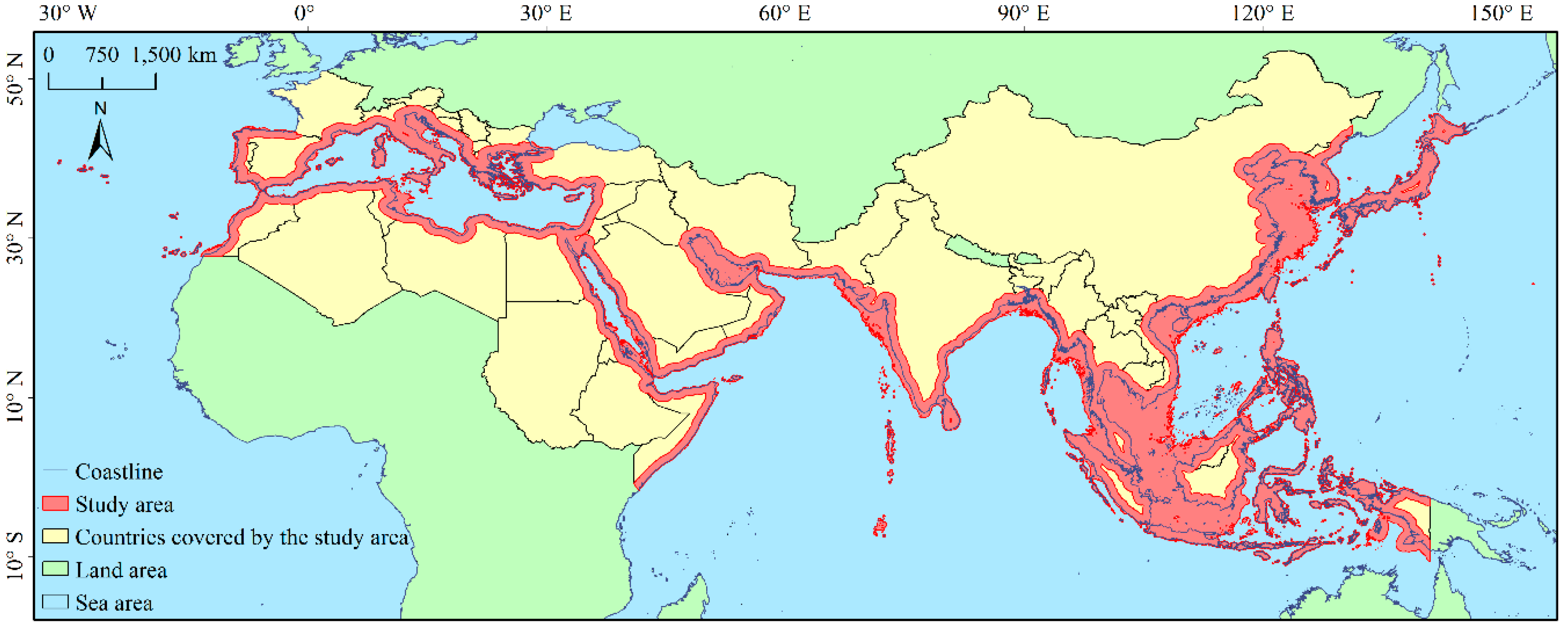

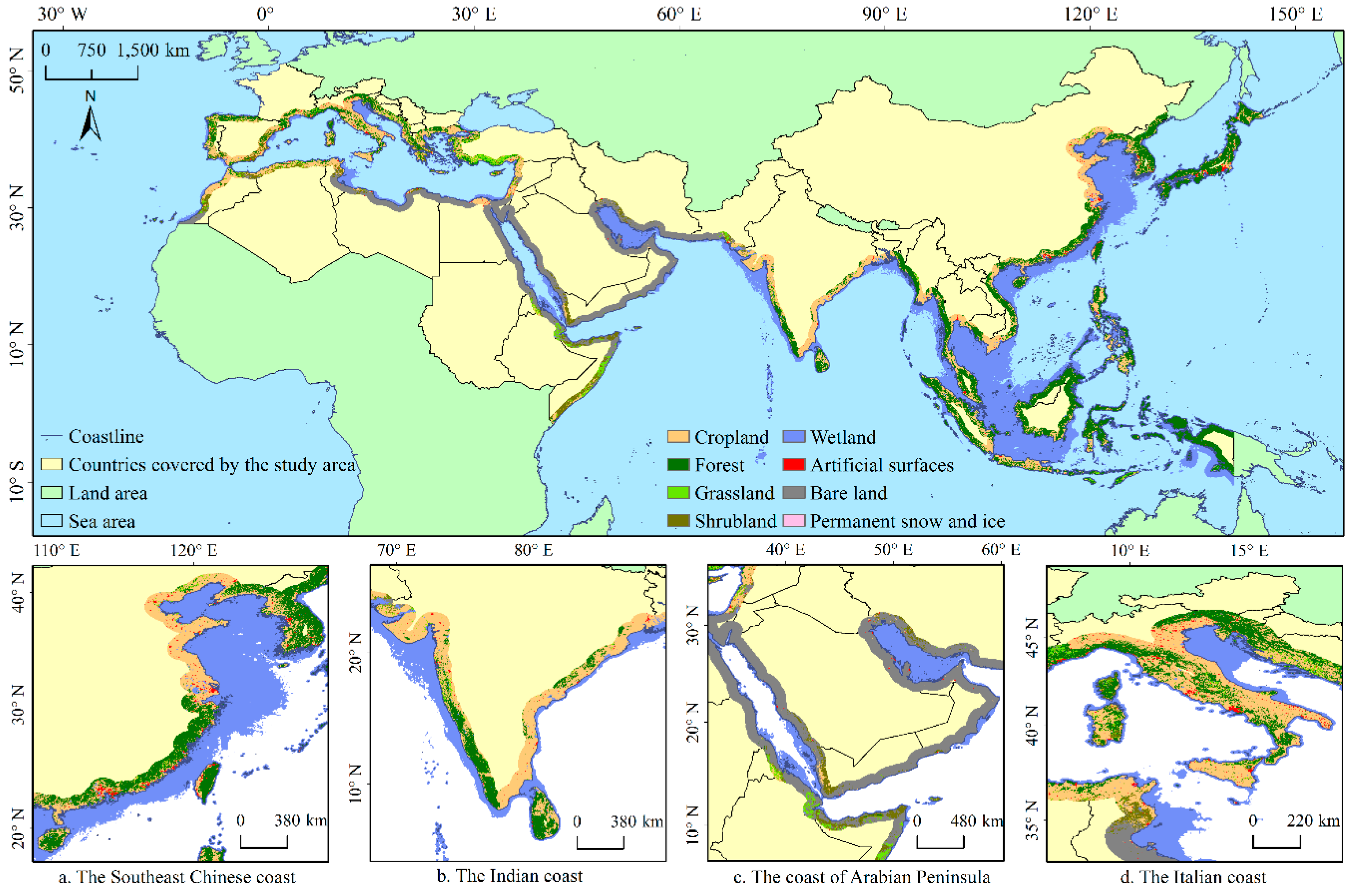
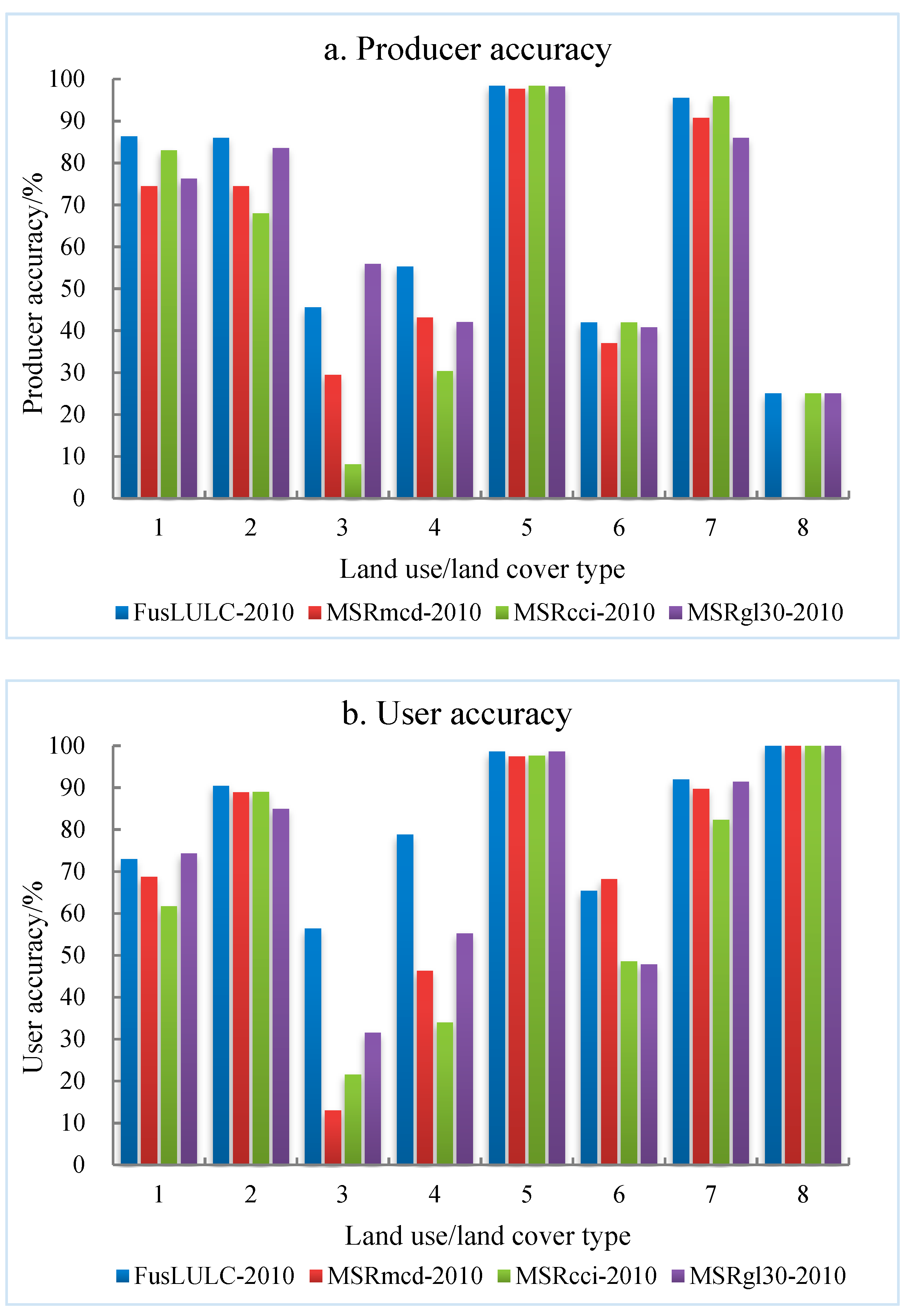
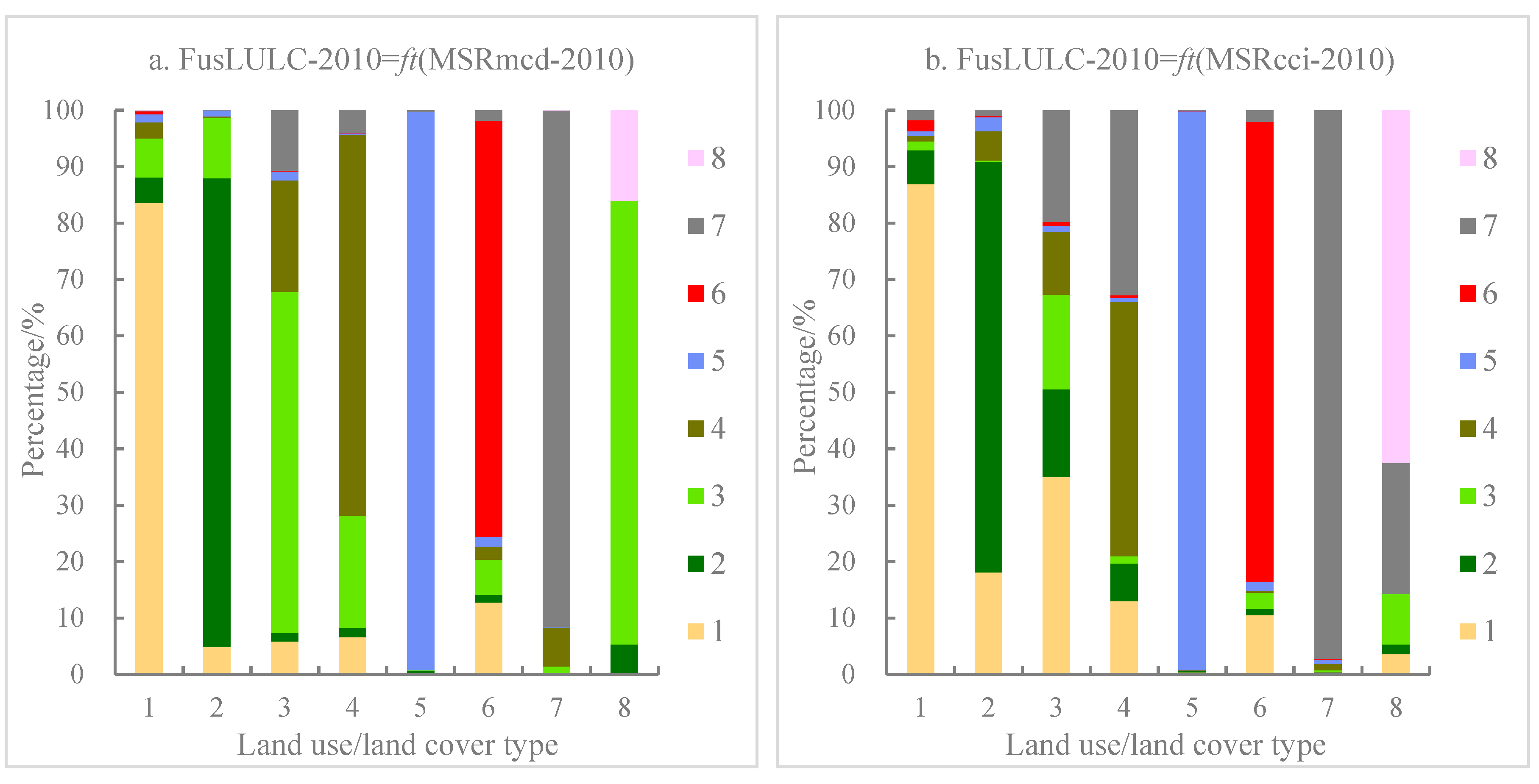
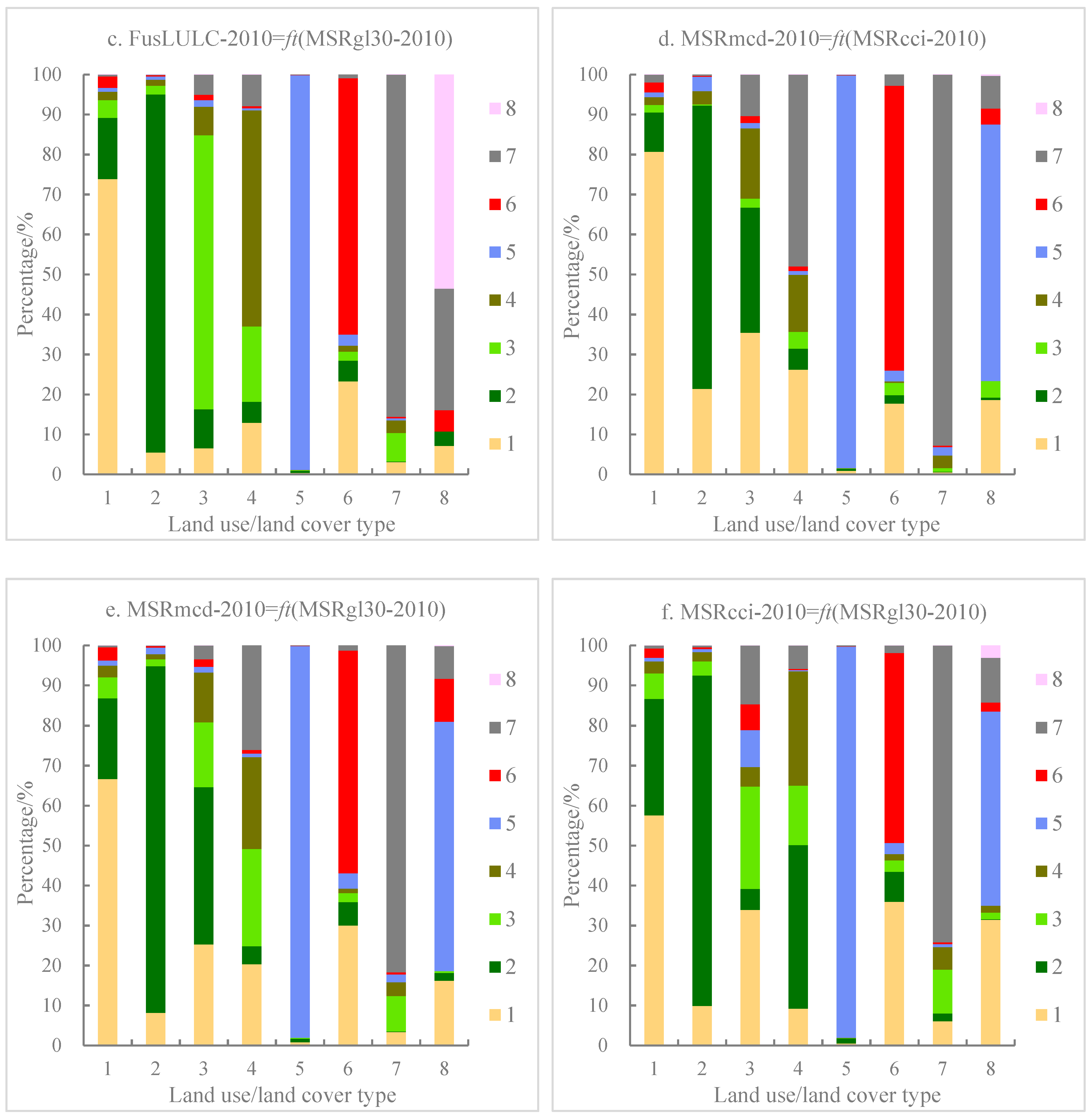
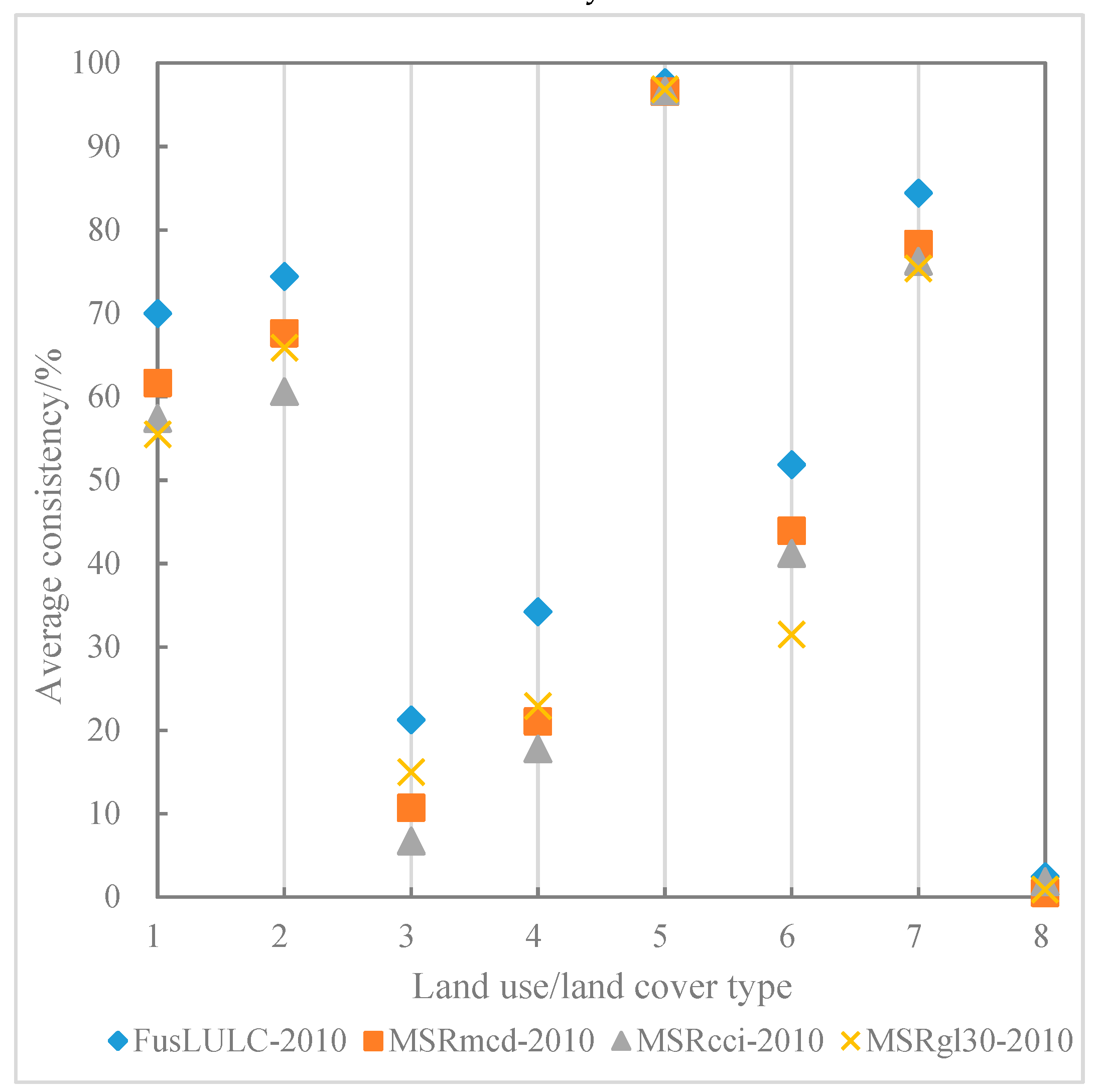
| Data Name | MCD12Q1 | CCI-LC | GlobeLand30 |
|---|---|---|---|
| Period/year | 2010 | 2010 | 2010 |
| Resolution/m | 500 | 300 | 30 |
| Overall accuracy/% | 71.6 | 70.8 | 80.3 |
| Sensor | MODIS | MERIS, SPOT-VGT | Landsat-TM/ETM7, HJ-1A/b |
| Classification system | IGBP 17 classes | FAO LCCS 22 classes | 10 classes |
| Classification method | Decision tree | Neural network | POK-based |
| Creator | NASA | ESA | NASG |
| Download data URL | https://ladsweb.modaps.eosdis.nasa.gov/search/ | http://maps.elie.ucl.ac.be/CCI/viewer/ | http://www.globallandcover.com/GLC30Download/DownLoad.aspx |
| MCD12Q1-2010 | CCI-LC2010 | GlobeLand30-2010 | |||
|---|---|---|---|---|---|
| Croplands | 120 | Cropland, rainfed, herbaceous cover | 11 | Cultivated land | 10 |
| Cropland, rainfed, tree or shrub cover | 12 | ||||
| Cropland, irrigated or post-flooding | 20 | ||||
| Cropland/natural vegetation mosaic | 140 | Mosaic natural vegetation/cropland (>50%) | 30 | ||
| Mosaic cropland/natural vegetation (>50%) | 40 | ||||
| Evergreen broadleaf forest | 20 | Tree cover, broadleaved, evergreen, closed to open | 50 | Forest | 20 |
| Deciduous broadleaf forest | 40 | Tree cover, broadleaved, deciduous, closed | 61 | ||
| Tree cover, broadleaved, deciduous, open | 62 | ||||
| Evergreen needleleaf forest | 10 | Tree cover, needle-leaved, evergreen, closed | 71 | ||
| Tree cover, needle-leaved, evergreen, open | 72 | ||||
| Deciduous needleleaf forest | 30 | Tree cover, needle-leaved, deciduous, closed | 81 | ||
| Tree cover, needle-leaved, deciduous, open | 82 | ||||
| Mixed forests | 50 | Tree cover, mixed leaf type | 90 | ||
| Woody savannas | 80 | Mosaic herbaceous cover/tree and shrub (>50%) | 100 | Grassland | 30 |
| Savannas | 90 | Mosaic tree and shrub/herbaceous cover (>50%) | 110 | ||
| Grasslands | 100 | Grassland | 130 | ||
| Closed shrublands | 60 | Evergreen shrubland | 121 | Shrubland | 40 |
| Open shrublands | 70 | Deciduous shrubland | 122 | ||
| Permanent wetlands | 110 | Tree cover, flooded, fresh or brackish water | 160 | Wetland | 50 |
| Tree cover, flooded, saline water | 170 | ||||
| Shrub or herbaceous cover, flooded, fresh/saline/brackish water | 180 | ||||
| Water | 170 | Water bodies | 210 | Water bodies | 60 |
| --- | --- | Lichens and mosses | 140 | Tundra | 70 |
| Urban and built-up | 130 | Urban areas | 190 | Artificial surfaces | 80 |
| Barren or sparsely vegetated | 160 | Sparse shrub | 152 | Bare land | 90 |
| Sparse herbaceous cover | 153 | ||||
| Consolidated bare areas | 201202 | ||||
| Unconsolidated bare areas | |||||
| Snow and ice | 150 | Permanent snow and ice | 220 | Permanent snow and ice | 100 |
| Number | Type Name | Description |
|---|---|---|
| 1 | Cropland | Land used for agriculture, horticulture and gardens. |
| 2 | Forest | Land covered by trees, with vegetation cover over 10%. |
| 3 | Grassland | Land covered by natural grass, with vegetation cover over 10%. |
| 4 | Shrubland | Land covered by shrubs, with vegetation cover over 10%. |
| 5 | Wetland | Land covered by water bodies or wetland plants. |
| 6 | Artificial surfaces | Land modified by human activities. |
| 7 | Bare land | Land with no vegetation cover or vegetation cover lower than 10%. |
| 8 | Permanent snow and ice | Land covered by permanent snow, glaciers or icecaps. |
| Target Type | MCD12Q1-2010 | CCI-LC2010 | GlobeLand30-2010 |
|---|---|---|---|
| 1 Cropland | 120, 140 | 11, 12, 20, 30 | 10 |
| 2 Forest | 10, 20, 30, 40, 50 | 40, 50, 61, 62, 71, 72, 81, 82, 90, 100 | 20 |
| 3 Grassland | 80, 90, 100 | 110, 130 | 30 |
| 4 Shrubland | 60, 70 | 121, 122 | 40 |
| 5 Wetland | 110, 170 | 160, 170, 180, 210, 140 | 50, 60, 70 |
| 6 Artificial surfaces | 130 | 190 | 80 |
| 7 Bare land | 160 | 152, 153, 201, 202 | 90 |
| 8 Permanent snow and ice | 150 | 220 | 100 |
| Data Name | OA/% | Kappa Coefficient |
|---|---|---|
| FusLULC-2010 | 90.37 | 0.8617 |
| MSRmcd-2010 | 84.55 | 0.7800 |
| MSRcci-2010 | 84.43 | 0.7770 |
| MSRgl30-2010 | 87.14 | 0.8162 |
| Data Name | OA/% | Kappa Coefficient |
|---|---|---|
| FusLULC-2010/MSRmcd-2010 | 90.44 | 0.8654 |
| FusLULC-2010/MSRcci-2010 | 88.32 | 0.8339 |
| FusLULC-2010/MSRgl30-2010 | 89.09 | 0.8455 |
| MSRmcd-2010/MSRcci-2010 | 81.81 | 0.7438 |
| MSRmcd-2010/MSRgl30-2010 | 81.96 | 0.7467 |
| MSRcci-2010/MSRgl30-2010 | 81.28 | 0.7355 |
| Data Name | FusLULC-2010 | MSRmcd-2010 | MSRcci-2010 | MSRgl30-2010 |
|---|---|---|---|---|
| FusLULC-2010 | 89.29 | 90.44 | 88.32 | 89.09 |
| MSRmcd-2010 | 90.44 | 84.74 | 81.81 | 81.96 |
| MSRcci-2010 | 88.32 | 81.81 | 83.81 | 81.28 |
| MSRgl30-2010 | 89.09 | 81.96 | 81.28 | 84.11 |
© 2019 by the authors. Licensee MDPI, Basel, Switzerland. This article is an open access article distributed under the terms and conditions of the Creative Commons Attribution (CC BY) license (http://creativecommons.org/licenses/by/4.0/).
Share and Cite
Hou, W.; Hou, X. Data Fusion and Accuracy Analysis of Multi-Source Land Use/Land Cover Datasets along Coastal Areas of the Maritime Silk Road. ISPRS Int. J. Geo-Inf. 2019, 8, 557. https://doi.org/10.3390/ijgi8120557
Hou W, Hou X. Data Fusion and Accuracy Analysis of Multi-Source Land Use/Land Cover Datasets along Coastal Areas of the Maritime Silk Road. ISPRS International Journal of Geo-Information. 2019; 8(12):557. https://doi.org/10.3390/ijgi8120557
Chicago/Turabian StyleHou, Wan, and Xiyong Hou. 2019. "Data Fusion and Accuracy Analysis of Multi-Source Land Use/Land Cover Datasets along Coastal Areas of the Maritime Silk Road" ISPRS International Journal of Geo-Information 8, no. 12: 557. https://doi.org/10.3390/ijgi8120557
APA StyleHou, W., & Hou, X. (2019). Data Fusion and Accuracy Analysis of Multi-Source Land Use/Land Cover Datasets along Coastal Areas of the Maritime Silk Road. ISPRS International Journal of Geo-Information, 8(12), 557. https://doi.org/10.3390/ijgi8120557





